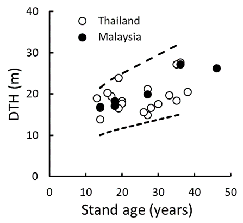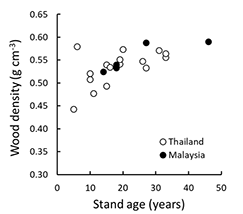Home > International Partnerships > Collaborative Research > Evaluation of the Suitability of Planting Teak (Tectona grandis) in an Unsuitable Climate Zone
Update:March 2, 2020
Main content starts here.
Evaluation of the Suitability of Planting Teak (Tectona grandis) in an Unsuitable Climate Zone

1. Partners
Universiti Putra Malaysia, Malaysia
2. Research Period
FY 2015-2017 Grant-in-Aid for Scientific Research (KAKENHI)
3. Lead Researcher
YONEDA, Reiji
4. Background
Teak (Tectona grandis) is a high-value timber species that naturally occurs in seasonally dry areas and so is generally considered unsuitable for planting in humid tropical areas because the high temperatures and precipitation affect the tree growth and wood quality. However, teak plantations have been planted under these climatic conditions in Malaysia, making it important that the growth characteristics and wood quality are assessed.
5. Research Goal
The objective of this study was to evaluate the growth characteristics of teak trees planted in an unsuitable climate zone in Peninsular Malaysia.
6. Research Strategy
We measured the growth characteristics [tree height and stem diameter at breast height (DBH)] and wood density in teak trees growing in six plantations (ranging from 14 to 46 years old) in six states in Peninsular Malaysia, which is considered to have an unsuitable climate for teak growth.
7. Scientific Achievement
The mean stem DBH, mean tree height, and dominant tree height (DTH) at the study sites varied from 18.0 to 26.4 cm, 12.0 to 21.2 m, and 16.9 to 27.3 m, respectively, while the wood density ranged from 0.52 to 0.59 g/cm3, all of which were within the usual range for teak trees growing in Thailand (Figs 1 & 2). Therefore, it appears that the growth characteristics and wood density of teak plantations in Peninsular Malaysia are comparable to those in Thailand despite the different climate characteristics.

Fig.1 Relationship between stand age and the dominant tree height (DTH) in teak (Tectona grandis) plantations in Thailand and Peninsular Malaysia (present study). The dotted line represents the range in DTH in Northeast Thailand, which was obtained from a yield table presented by Ishibashi (2010)

Fig.2 Relationship between stand age and wood density
8. Applications
The findings of this study indicated that contrary to previous belief, teak is a suitable plantation species in Peninsular Malaysia.
9. Publications
Reiji YONEDA, Tanaka KENZO, Tomoaki ICHIE and Mohamad Azani ALIAS (2017) Comparison of growth on planted teak among four sites in Peninsula Malaysia.Kanto Journal of Forest Research 68(1): 37-40.
Reiji YONEDA, Tanaka KENZO, Tomoaki ICHIE, Mohamad Azani ALIAS, Nor Zaidi JUSOH, Amir Saaiffudin KASSIM and Ahmad Zuhaidi YAHYA (2018) Growth and wood density on planted teak among six sites in Peninsular Malaysia. Kanto Journal of Forest Research 69(1): 3-6.
Copyright © Forest Research and Management Organization. All rights reserved.
